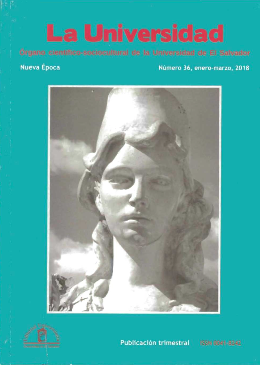Estudio de plantas alimenticias consumidas por la población en el Área Metropolitana de San Salvador (AMSS) y municipios aledaños
Fase I
Keywords:
El Salvador, Nutrition, Food plants, Proximal analysis, Native plants, Naturalized plants, Exotic plantsAbstract
Malnutrition is one of the characteristics of "Iow- and middle-income" countries as El Salvador; but poverty is not the only cause of the problem, since malnutrition can also be explained taking into account variables such as culture, that influences people to sells their nutritious foods and to purchase other with less or no nutritional value, indueed by propaganda of social media. Aecording to Food and Agriculture Organitation (FAO) El Salvador ranks tenth in Latin America in the prevalence rote of obesity in adults over 20 years with a 27.0 %, this inereases the risk of ehronic diseases sueh as hypertensiol1, diabetes, cancer; among others, having an impaet on the quality oflife ofindividuals (1). In order to positively influence to salve this problem, there have been important hut insufficient contributions to the reseue of the edible plants in the region. In this study, a survey was conducted in the AMSS and surrounding municipalities, obtaining a total of 91 plants with their common names - 45 exotic, 39 native, and 4 naturalized-, ofwhich 88 could be identified taxonomically and 3 could not be I identified beca use no references in the different databases were found. Also the results were compared with other listings, [inding 7 species that have notyet been reported. Finally the ten species with the highest frequency ofuse and their nutritional value, coincidentally evaluated species higher nutritional value are the same as reported a higher frequency of use, which are: Solanum nigrum -blackberry- (22.20 %), Crotalaria longirostrata -chipilín- (18.33 %), and Spinacia oleracea, -spinach- (12.20 %).
Downloads
Downloads
Published
Issue
Section
License
Copyright (c) 2022 Authors who publish in Revista La Universidad agree to the following terms: Authors continue as owners of their works, non-exclusively assigning dissemination rights to La Universidad Journal under the standards of the Attribution-NonCommercial-ShareAlike License: CC BY-NC-SA 4.0. This license allows the use of a work to create another work or content, modifying or not the original work, as long as the author is cited, the resulting work is shared under the same type of license and has no commercial purposes(https://creativecommons.org/licenses/by-nc-sa/4.0/deed.es).

This work is licensed under a Creative Commons Attribution-NonCommercial-ShareAlike 4.0 International License.





